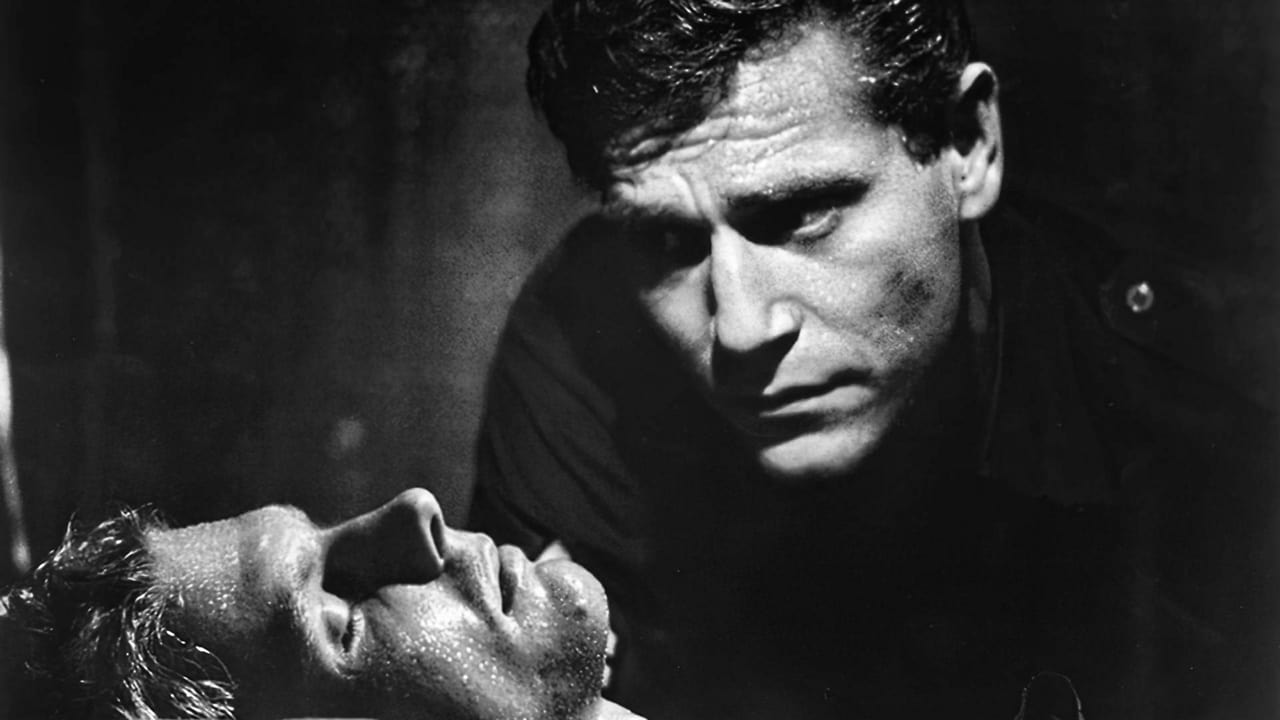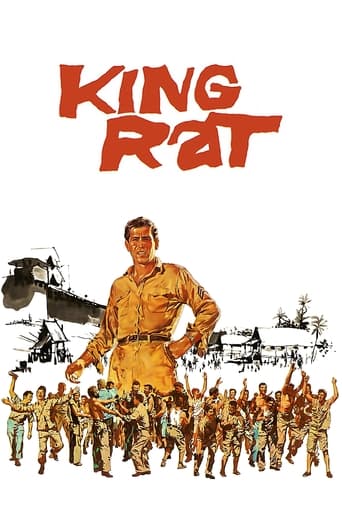Interesteg
What makes it different from others?
Inadvands
Boring, over-political, tech fuzed mess
Dynamixor
The performances transcend the film's tropes, grounding it in characters that feel more complete than this subgenre often produces.
Teddie Blake
The movie turns out to be a little better than the average. Starting from a romantic formula often seen in the cinema, it ends in the most predictable (and somewhat bland) way.
James Smith
I'm not sure whether it's because it really should have been filmed in the tropics, or that Grey, the provost, is played by the wrong actor, or that most of the actors are too old, that this film just doesn't seem to work.Grey need a far more imposing actor, someone with more charisma and authority. Someone who would be feared and respected by the other POWs. Instead, because of the actor mismatch, Grey's character seems quite weak.A lot of the POWs appear to be over forty or older. Maybe they couldn't get thinner, younger actors?The guards lack the menace that films such as The Bridge on the River Kwai portray.Being filmed in black and white just adds more to the negatives (pardon the pun) of this film.It would probably have made a good stage play, but this screen version, along with the musical soundtrack, could not hold my interest.
Naught Moses
Lawrence Kohlberg wrote a controversial and much discussed paper about the stages of moral development at the U. of Chicago in 1958. Kohlberg asserted that moral development ranged from conditioned obedience and fear of punishment through self-interest, conformity, authority for the sake of maintenance of social order, and consciously made social contracts, to awareness of universal ethical principles. While still subject to argument, a number of psychometric tests have been adapted or specifically developed to test the accuracy of Kohlberg's notions. To this day, his ideas strongly influence measures of anti-social, sociopathic and sadomasochistic thought and behavior in criminal justice and other endeavors. Take a look at it on, say, Wikipedia, and then watch "King Rat" closely to see where the various major characters fall on the scale. Further, one can utilize "KR" as an illustration of socialized, acculturated, "normalized," and belief-bound -- vs. chillingly empirical, anti-socialized, anti-ac-CULT-urated, ab-normalized, observation-driven -- appraisal of events. The former may well be "just" and "fair," but relatively ineffective when it comes down to survival... and the latter may be "ruthless" and "vicious," but relatively effective therefor. "KR" demands one climb out of the box of "delivered truth" based on authoritarian in-struct-ion to "get it." In modern neuropsychological parlance (see, for example, Iain McGilchrist), it requires that one pretty much abandon the rules and regulations of the brain's verbal- symbolic-skewed left hemisphere for the open-mindedness of spatial- sensory-skewed right. Even though the 1950s had been a watershed decade for existentialism and the 1960s a decade of wider distribution therefor, "King Rat" was =far= ahead of its time in the English-speaking world. But if one could have seen it in the Russian-speaking one (not possible during the Cold War, after all), anyone who'd read Dostoyevsky and Chekov -- let alone lived in a gulag -- would have sussed it immediately. RG, Psy.D., "The 12 StEPs of Experiential Processing," online.
stancym-1
I just read all the reviews of King Rat which I first saw as a kid in 1967. It knocked me out then and it has knocked me out the few times I have seen it since. I decided to read the reviews before deciding whether or not to tape it tomorrow at 4 AM for yet another viewing. There is little to add to all that has already been said, except: James Fox made an incredible debut in his first film, The Servant, which is also WELL worth viewing--another outstanding British black-and-white film of the sixties. It was a real loss when he quit acting for so many years. Thankfully, he returned. Recently he was in an episode of an Inspector Lewis mystery on PBS, and his character was witty and "delicious" and he played the part to the hilt.Tom Courtenay is also a wonderful actor who has not been in nearly enough films. Perhaps I will look at his provost character in King Rat less sympathetically after reading all these reviews. I think it is just that I like Courtenay so much and he is such a good actor, I have to work to dislike his straight-laced, stubborn, rigid but highly ethical character in the film.George Segal was never so impressive again as he was in this film, although I did like him in Virginia Woolf and in A Touch of Class. He just never seemed quite like a true movie star to me. Didn't "blow my skirt up" as they say.....It's definitely a classic film about how the will to survive while not going mad will bring out the basest and most selfish aspects of mankind. I don't know if a lot of other women enjoy World War 2 films and POW films, but I do. With or without "romanticized patriotism," which this film certainly avoids! This is a must-see film and the entire cast is superb as is the script and direction. Like other reviewers, I wish this film were better known.
James Hitchcock
Despite the viciousness of the Nazi regime, British and American prisoners of war captured by the Germans in World War II were generally honourably treated in accordance with the Geneva Convention and given adequate food and accommodation. Those captured by the Japanese were not so lucky. They were often treated brutally, kept short of food and used as slave labour for their captors. This may explain the difference in tone between prisoner of war films set in Europe and those set in the Far East. The former, such as "The Wooden Horse", "The Colditz Story" and "The Great Escape" are generally optimistic in tone, part of the tradition of heroic, patriotic war films. The prisoners are often shown as idealistic patriots, eager to escape from captivity so that they can carry on the just struggle against Nazism.In "King Rat", however, as in that other Asian POW drama "Bridge on the River Kwai", the tone is very different. There is no realistic possibility of escape, as there are no neutral countries nearby. Life for the prisoners is a dog-eat-dog struggle for survival, one that often involves compromises with one's principles and with the enemy. "Bridge on the River Kwai" is unusual for a Western film in that it gives a relatively sympathetic portrayal of an Axis soldier, the Japanese commandant Colonel Saito. In "King Rat" no Japanese characters play a major role; the emphasis is very much on relations between the Allied prisoners themselves. The shortages of food and other necessities mean that a black market has grown up in which the prisoners barter their possessions with the camp guards and local Malay villagers in exchange for extra supplies of food, clothing and luxuries.The "King Rat" of the title is an American prisoner, Corporal King. Despite his lowly rank, his surname is an appropriate one; his skill in exploiting the black market has made him the "king" of the camp. The "rat" part of the title may refer to a scheme he hatches for breeding rats as a food source, but it may also refer to his lack of moral scruples. The other major characters are two British prisoners, Flight Lieutenant Peter Marlowe and Lieutenant Robin Grey. Marlowe, a young RAF officer, is befriended by King, who is impressed by the younger man's command of the Malay language, and becomes King's official interpreter in his business dealings. Grey is only a junior officer, but wields considerable power because of his position as Provost-Marshal, in charge of enforcing military discipline in the camp. He develops an obsession with King, whom he is determined to see punished for his black marketeering.The film can be seen as an exploration of the theme of capitalism versus socialism, with the former coming out on top. (Perhaps unsurprisingly, given that this was an American film made during the Cold War era). King is a selfish individual, without a single altruistic bone in his body, yet his pursuit of self-interest has the effect of making life more bearable for his fellow-prisoners. Grey, a man of left-wing socialist views, is outwardly idealistic and a believer in fairness and equality, but he is also petty and vindictive with a bureaucratic obsession with enforcing rules (even rules imposed by the enemy) for their own sake. Without the extra supplies provided by the black market, the inmates would be forced to exist ("live" is not really the appropriate word) at near-starvation levels.The film is not, however, just a political parable. It is also a human drama about the stresses facing men in captivity, and there are some memorable performances. The role of King was turned down by Steve McQueen, who had starred in "The Great Escape", and by Paul Newman, who was later to star in another great drama about men in captivity, "Cool Hand Luke". In the event it went to George Segal, who turns in a fine performance as the amoral yet resourceful King, as do James Fox as the naïve, impressionable Marlowe and Tom Courtenay as Gray. There are also good contributions from various distinguished British actors such as John Mills, Denholm Elliott and Leonard Rossiter.The film was directed by Bryan Forbes, who was also responsible for that great British classic, "Whistle Down the Wind". I would not rate "King Rat" quite as highly, but despite the very different subject-matter of the two films both are distinguished by a similarly stark black-and-white photography. "King Rat" was deservedly nominated for an Academy Award for "Best Cinematography, Black-and-White". This is, of course, an award which is no longer given; the decline in the number of black-and-white films being made has meant that since 1967 there has only been a single "Best Cinematography" award. Nevertheless, films like "Whistle Down the Wind" and "King Rat" remind us of how powerful monochrome could be as a dramatic medium. 8/10

